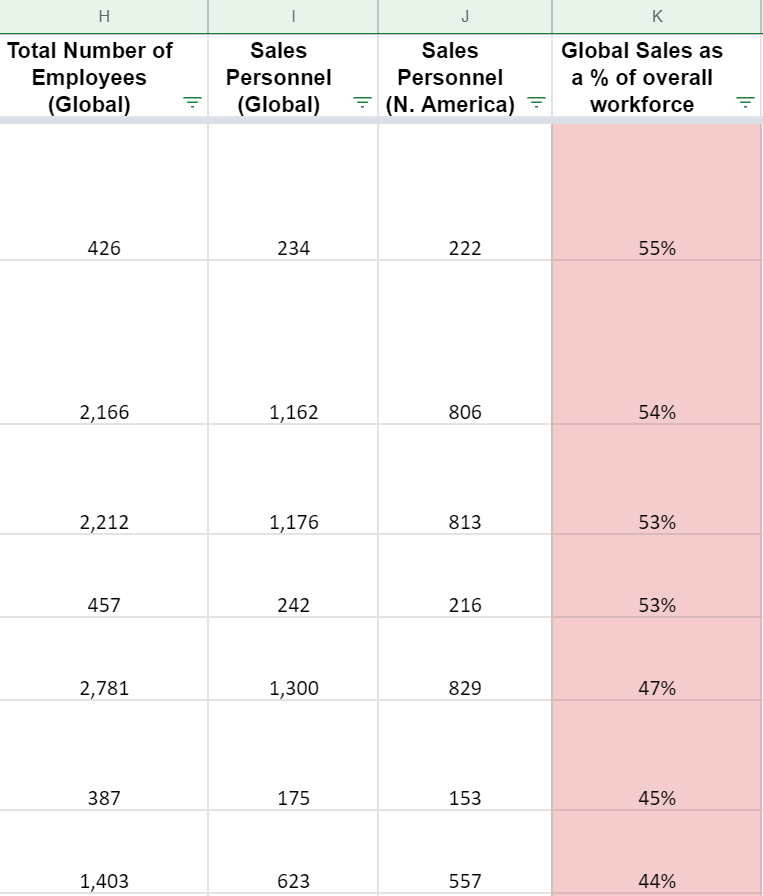How to Prioritize Which Accounts to Target First in *Account-Based Selling*

Whether it’s the beginning of the year and you’re staring at your new list of net new target accounts or you’re midway through the year and simply need a pipeline boost, prioritizing which accounts to target first is an essential part of attaining quota. This should be an objective and systematic process. For us, it all begins with getting the no-brainers out of the way. These will be the list of the ones you know, for sure, you don’t want to touch and the ones you know, for sure, are ripe for the taking this fiscal year.
No-Brainer Eliminations:
- Former customer with recent churn. They’re probably not buying from your company again anytime soon.
- Recently-lost opportunity: If the previous rep just went through a cycle there and lost, they’re probably not looking again this year. You could always set a little touchpoint with the previous stakeholders to see how the winning competitor is performing, but it’s not an account you want to spend a lot of time, or any time, prospecting into.
No-Brainer Keepers:
This is always going to be specific to your company, so be sure you know what your ideal customer profile looks like. If you’re not aware, and marketing or sales enablement doesn’t have these answers, then I recommend speaking with a highly-successful and proven sales person within your company to learn from them. Try to keep it to 30 minutes. But if they offer more, take it:
- When prioritizing which accounts to target, what do you personally look for?
- What characteristics of a prospective account get you excited and why?
- What kind of accounts/situations frustrate you or are more difficult than others, if any?
- Are there any situations you just flat-out avoid?
- What have been your best points of entry into a net new account?
- What roles typically have the most influence in your deals and why?
- If you were in my shoes, what are the top 3-5 things you would be doing and what are the top 2-3 things you would be avoiding (time wasters/distractions)?
Be sure to send a nice “thank you” gift afterwards as well – $50-$100 of value…don’t be cheap. Great sales people value their time, so show them how much you valued it. This gesture will also help you establish a relationship with a top performer which can pay meaningful dividends down the road. Maybe ping their manager with something like, “Hi, Jocelyn. Brandon helped me out quite a bit the other day and I wanted to send him a thank you. Do you know what he enjoys?” Could be dinner, a bottle of something, Top Golf, etc..
So, not only did you learn a ton from a top performer, you established positive relationships with both a top performer and his manager, plus Brandon got a cool gift and his manager was made aware of how he helped you, which looks good on him. All for $100. Easy decision.
JOINT ACCOUNT TARGETING IN PARTNER CO-SELL MOTIONS ISN’T REMOTELY AS EASY
Getting back to no-brainer accounts:
For us, here at Forecastable, an example of a no-brainer keeper is:
- CRM: Salesforce or Microsoft Dynamics
- Internal Communication: Slack or Teams
- Enrichment Provider: ZoomInfo
- Roles
- Has enterprise sales and customer success roles
- Has Chief Sales Officer or Chief Revenue Officer
- Sales Team/All Employees: Greater than 30% of all personnel are in the sales department (see screenshot below of a basic spreadsheet we built internally for prioritizing accounts). Those with a higher percentage we consider to be sales-driven organizations
- …we’ve got a few more, but we’re not trying to give away all of our secret sauce here.

Once you’ve got your no-brainer keepers down, immediately get those outbound motions in place (Account Research, Stakeholder Research, then personalized outbound cadences). Hopefully you’ve got some SDR/BDR professionals on deck, ready to team with you and lead the charge.
Will those be enough accounts though? Not sure. To tell, start by assuming you’re only going to generate opportunities in one third of the accounts you target. Let’s say that leaves you with 15 opportunities and your average deal size is $80,000. That’s $1.2M in pipeline coverage. Your annual quota is $1.4M and you know your pipeline needs to be 3X your annual target to hit your number, so you’re definitely short here.
This means you have to work some of the ones that aren’t no-brainer keepers. Prioritizing those can be as simple, for some, as slowly removing requirements from your “no-brainer keeper” profile above. In our case, maybe we’d remove the 30% sales personnel requirement and drop that to 25% or maybe we’ll entertain those prospects that don’t have a CSO. Just slowly remove some requirements and your next targets will begin to surface. Rinse and repeat as necessary.
JOINT ACCOUNT TARGETING IN PARTNER CO-SELL MOTIONS ISN’T REMOTELY AS EASY
Uncover Your Growth Potential
Whether starting with a single sales team or a single partner, any co-sell motion can be live within 30 days.
Schedule a Discovery Call



